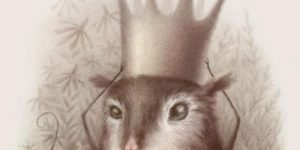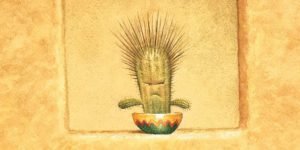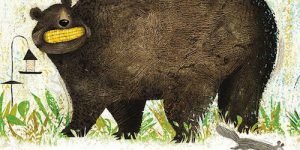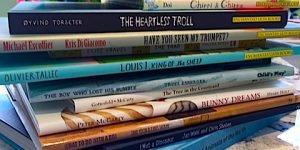I’ll go out on a limb (without a prehensile tail, I might add) and state, unequivocally, that Anthony Browne is the best monkey artist of all time. Perhaps if Van Gogh had painted a field of monkeys instead of a field of sunflowers, I would have reason to adjust my statement, but he didn’t, and so Browne is, and will always be, the King of Kongs.
One of my earliest memories of working in the bookstore was a woman flapping a copy of Gorilla by Anthony Browne in my face and vehemently stating, ‘This book is about child abuse, and it should be removed immediately!” I had not read the book, but as I flipped through it with the woman hyperventilating beside me, I felt like thanking her. Of course it wasn’t about child abuse and I didn’t remove it, but from that point on I became a fan of Anthony Browne.
Little Beauty is based on the true story of a gorilla named Koko, who was taught American Sign Language at the San Diego Zoo. In Browne’s book, he has everything he needs, including an overstuffed chair, William Morris inspired wallpaper (and upholstery), a TV, and burgers, but what he wants is a friend. Cue the kitten, named Beauty. The two of them become inseparable. While watching King Kong on TV, the gorilla becomes incensed, and destroys the television. Can’t argue with the gorilla. None of the versions of that movie have been very satisfying. Fearing for Beauty’s safety, the zookeepers are just about to take her away when the kitty signs, “It was ME. I broke the television.” (Wow. I wish my cat would fess up to her periodic fits of destructiveness.) Of course, it wasn’t really a confession, it was an act of friendship. Beauty didn’t kill the TV, it was the Beast.
UK-based Anthony Browne is the illustrator of more than 4o picture books, quite a few of which incorporate monkeys to a greater or lesser degree. The large scale format of Little Beauty is a perfect showcase for the gorgeous close-ups of this loveable gorilla and the hyper-realistic style of the watercolour paintings. However, Browne throws in a few pencil sketches for additional visual interest, which is not unusual for an artist prone to media-mixing. In a recent book, Into the Forest, 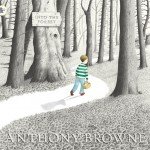 Browne beautifully integrates images of children painted in bright watercolours with black and white pencil illustrations of a fairytale forest. It’s darkly intimate, and quite different from the boldness of Little Beauty. However, as with all Anthony Browne books, the exquisite detail in his illustrations, the love of pattern, and his playfulness with imagery-especially background imagery, is what distinguishes Browne’s work from his peers. There is always something else going on in Browne’s illustrations. A story within a story. An ape within a rose.
Browne beautifully integrates images of children painted in bright watercolours with black and white pencil illustrations of a fairytale forest. It’s darkly intimate, and quite different from the boldness of Little Beauty. However, as with all Anthony Browne books, the exquisite detail in his illustrations, the love of pattern, and his playfulness with imagery-especially background imagery, is what distinguishes Browne’s work from his peers. There is always something else going on in Browne’s illustrations. A story within a story. An ape within a rose.
If a gorilla (or chimp, or ape) is not the featured player in one of Browne’s books, they show up in the wallpaper, or in a painting, or flower, or metaphorically as banana endpapers. In a Guardian article from 2009, Browne was asked to explain his fascination with gorillas. He replied: “…well, they’re glorious to draw, in the way old people’s faces are – all the lines…it’s (also) to do with my dad, I think. He was a big man, but kindly, and gorillas are like that: powerful, capable of aggression, but mostly gentle, sensitive.” Browne published a series of books about a chimpanzee named Willy, who serves as a both a cardigan-wearing muse and as a surrogate for Browne, who like Willy, is prone to daydreaming and generalized hairiness. The best of these is Willy’s Pictures, which is a collection of famous paintings re-imagined with Willy as a central character. It’s fabulous. You’ll never think of the Creation of Adam by Michelangelo in the same way again.
However, in a long career of little masterpieces, Anthony Browne has achieved the apex of his ape-centristic oervre with Little Beauty. It’s a real stunner.
Like another illustrator I’ve reviewed in this blog, Lisbeth Zwerger, Anthony Browne was awarded the most prestigious honour in children’s illustration, the Hans Christian Andersen Medal, in 2000. Browne was named UK’s sixth Children’s Laureate in 2009. Each of his books are worthy of a review, and I hope to be able to do just that in future posts. In the meantime…
Great in-depth interview with Anthony Browne in this Guardian article from 2009.
Little Beauty by Anthony Browne, published by Candlewick Press, 2008 ISBN: 978-0763639594
Into the Forest by Anthony Browne, published by Candlewick Press, 2004 ISBN: 0763625116 (to be reviewed)
Willy’s Pictures by Anthony Browne, published by Candlewick Press, 2000
Gorilla by Anthony Brown, reissued by Candlewick Press, 2002 (orig pub 1983)
And…of course he couldn’t resist…
Anthony Browne’s King Kong, published by Turner Publishing, 1994 (fantastic!)




